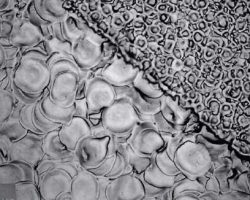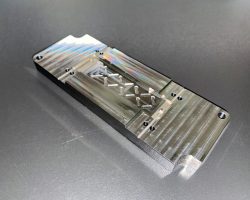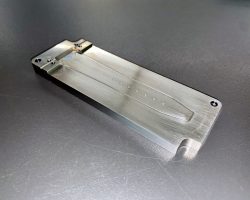Die sinking: principles, basics, and function
When other processes reach their limits due to the material properties, die-sinking EDM performs with excellent dimensional accuracies and surface qualities. High-tensile alloys and all electrically conductive materials – regardless of the degree of hardness and material thickness – can be shaped with extremely small cutting widths and optimum accuracies. Even complicated 3D shapes of the highest quality are feasible.
What is die sinking?
Die-sinking EDM is a special spark erosion process and figures among the material-removing manufacturing processes. The principle is based on the eroding force of electrical charges, this enables the machining of all electroconductive materials regardless of their strength and intended shape. Die-sinking EDM has therefore become a very important technology in the manufacturing industry.
How does EDM work?
Die-sinking EDM is based on the physical removal principle: During spark-erosive machining, the material is removed by brief, locally separated electrical spark discharges. The erosion process takes place in an electrically non-conductive aka dielectric fluid. Both the electrode and the workpiece are placed in a dielectric liquid. We differentiate three phases:
Ignition phase:
A wire or a solid electrode (+) and the workpiece (-) are placed at a predefined distance (working gap). The application of an electric voltage leads to the formation of an electric field. Collision processes of the accelerated electrons and ions convert kinetic energy into thermal energy. If the dielectric liquid evaporates, new charge carriers are generated. A discharge channel in the shape of a plasma gas bubble forms: the clearly visible spark.
Discharge phase:
As the electrical current flow increases, the discharge channel expands. The surrounding dielectric is tough and creates a counterpressure constricting the discharge channel at both the electrode and the workpiece. Due to the high current density, intensive heating, melting, and vaporization of the material can be achieved.
Interval phase:
The voltage is switched off. The gas bubble implodes and the remaining smeltery is ejected. The dielectric rinses the solidified ablation particles.
What are the advantages and possible applications of die-sinking EDM?
Die-sinking EDM can be applicated in tool and mold making. Typical scopes of application are the pressure of die casting molds, complicated 3D molds, forging dies, or undercuts. The manufacturing process takes place on contour-controlled EDM machines, which offer a wide variety of shapes due to superimposed movements in all axes. EDM stands out with perfect accuracies, especially in the production of components with narrow and deep contours. Even when it comes to large material thicknesses, extremely small cutting widths can be realized – with optimum shape accuracy and linearity. Excellent surface finishes of up to Ra 0.11, highly polished surfaces, and manufacturing tolerances in the micro range are feasible.
What are the costs?
Due to long shaping times and the complex production of accurately shaped electrodes, the costs are quite high. This fact is most noticeable when it comes to individual parts and small batch sizes. Also, design, material, and manufacturing costs plus labor expenses must be taken into account.
Which electrodes are suitable?
All electrodes with good electrical conductivity, a high melting point and low electrical resistance are applicable. Also, the size of the spark gap and the wear have to be considered. The most common materials used are copper, graphite, tungsten-copper, and copper-zinc alloys.
How do you construct a die-sinking EDM machine?
Die-sinking EDM machines are CNC-controlled systems. Usually, they are designed as bath machines due to the dielectric liquid. A feed and bearing control, a generator for producing the discharge current, and a container with filter and pump for the dielectric are required.
How accurate is die-sinking EDM?
Die-sinking EDM machines shape with the maximum accuracy of all mechanical applications. Surface qualities of up to Ra 0.05 µm and manufacturing tolerances of 2 μm can smoothly be achieved. The die-sinking performance can be optimized by using oil as a dielectric as well as specially refined electrode material.
When is die-sinking EDM useful?
Die-sinking EDM is suitable for a precise production of complex molds made of materials that are difficult to shape, especially in tool making and mold making. Typical examples are injection molds, forging dies, prototypes or components for turbine construction, or automotive engineering.
Thanks to our new, high-precision die-sinking EDM machine for the micro range, we are capable of eroding the smallest and finest cavities, slots, and contours of any kind. With a smaller number of electrodes, we achieve minimum corner radii of < 0.02 mm. This reduces the manufacturing effort and increases productivity. An extremely high repeat accuracy makes the required machining perfection feasible. Due to an exceptionally high surface quality as well as the highest detail accuracy – even when utilizing micro electrodes – parts for the highest demands can be eroded. By producing 3DS surfaces, it is possible to improve the anti-scratch characteristics of the plastic parts as well as to achieve an adjustable gloss level of the finished plastic part. Furthermore, the 3DS surface process reduces the adhesion of the plastic part during the injection process in the mold. This enables us to increase the de-molding speed during spraying and to reduce the accumulation of residues during the spraying process in the mold. These facts have a positive effect on maintenance times, costs, and productivity.
Contact and advice
For further information or individual advice on your project, please contact us at info@retero.swiss.
Retero GmbH
Stadtweg 24
8245 Feuerthalen
Switzerland
TECHNICAL SPECIFICATIONS FOR DIE SINKING
- Surface roughness up to Ra 0.08
- High detail accuracy
- Exceptionally high surface quality
- Diminutive corner radii – even with deep sinking < 0.02 mm
- Shaping of special materials such as ceramics and hard metals
- Processing of other materials such as hardened, alloyed, or stainless steels (INOX), non-ferrous metals
- Clear advantages of 3DS surfaces:
-
- Appearance and quality – customizable gloss level of the plastic parts, improvement of anti-scratch characteristics.
- Reduced adhesion of plastic parts in the mould allows increased demoulding speeds
- Less residue accumulation in the mould reduces cleaning and maintenance times, allows longer moulding autonomy
You’ve got the issue – RETERO GmbH comes with the solution
We specialize in manufacturing of micro and small parts made of conductive materials, especially of ceramics and hard metals.
frequently asked questions & answers
A die-sinking EDM machine consists of a machine tool, a control unit for the axis drives, a generator, and the dielectric unit. Drives in three spatial planes take over the feed movement and the positioning of the electrode. Die-sinking EDM machines are mostly built as bath machines where the workpiece is located in a bath of dielectric, a non-conductive oil. The machine head is movable and performs the movement in the z axis. The table performs the movements in the x and y axes. Die-sinking EDM machines are available as conventional machine tools or as CNC-controlled machines.
The material removal happens thermally: in die-sinking EDM, the electrode tool is moved to a narrow gap against the workpiece until a spark jumps the gap. The material melts or vaporizes during the discharge phase and is ejected either by the gas bubble created in the dielectric or by the dielectric medium supplied under pressure.
As the material removal progresses, the gap between the tool and the workpiece increases until no spark can jump over. That’s why the tool enters the workpiece at a feed rate adapted to the material removal volume. The electrode material is selected according to the material to be machined and the geometry to be produced. Usually, copper and graphite are used for this. There must always be a small gap between the tool (cathode) and the workpiece (anode) in order to cool down the workpiece and to ensure the removal of the detached material. Depending on intensity, frequency, duration, length, gap width, and polarity of the discharges, a wide variety of removal results can be produced, even very complicated geometric shapes are feasible.
The spark gap is the space between the workpiece to be machined and the electrode. Material removal does not take place during direct contact between the workpiece and the electrode: the process is contactless, and the spark jumps over at a certain proximity. This spark or working gap normally has a size of 0.004 to 0.5 mm. The width of the spark gap depends on the parameters set on the machine, such as electrical voltage, current intensity, discharge interval, or pause interval, and is highly dynamically adjusted to the set value. The higher the removal rate, the larger the spark gap and the rougher the surface structure.
Due to its almost infinite possibilities in metalworking, die-sinking EDM is being used more and more frequently. All electrically conductive materials can be worked on, such as metals, hardened steel, graphite, alloys, or ceramics – regardless of their hardness. Even the most challenging materials such as carbide, molybdenum, tantalum, and tungsten can be eroded.
Die-sinking EDM is mainly used in tool design and construction. Even very special shapes and complex recesses are feasible. Die-sinking EDM is also used in drive technology, the automotive industry, aviation, energy technology, mold making, research/development, the household and entertainment appliance industry, linear drives, mechanical engineering, medical technology, measurement technology, the toy and electronics industry, injection molding machines, particle accelerators, turbine construction, the watch industry, fixture construction, or defense technology.
Die-sinking EDM offers exceptional dimensional accuracy and surface quality, making it suitable for materials with varying hardness and thickness. It excels in shaping high-tensile alloys and other conductive materials, including complex 3D shapes.
Die-sinking EDM can achieve surface finishes of up to Ra 0.05 µm and manufacturing tolerances as tight as 2 μm. This precision makes it a preferred choice for producing intricate molds and components.
Die-sinking EDM is compatible with a wide range of materials, including metals, hardened steel, graphite, alloys, ceramics, and even challenging materials like carbide, molybdenum, tantalum, and tungsten. It’s a versatile process for working with electrically conductive materials.
Die-sinking EDM finds applications in various industries, including tool design, automotive, aerospace, energy, mold making, medical technology, electronics, and more. It’s often used for complex shapes, recesses, and precision components across diverse sectors.




